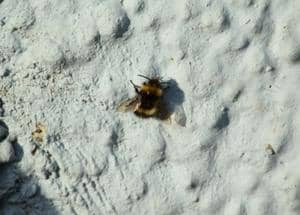Even despite the fact that bees very rarely sting people, a nest in the wall may be very dangerous for the house inhabitants. It’s extremely important to identify a hive in time and take appropriate measures.
However, getting rid of a beehive in house wall is not an easy task that includes a bunch of methods. In the article, we’ll tell you how to get rid of bees in wall and describe the most effective and widely used techniques.
Removing bees from the wall includes bee type identification, getting rid of the nest, and taking measures to prevent bees in the future. So, let’s dive into the “how to get rid of bee hive in wall” question.
Which Bees Build Their Hives in Walls and How to Identify Them
It’s very important to identify the bee type correctly and make sure that you are dealing exactly with bees but not wasps or hornets. However, it’s pretty hard to distinguish between domestic and wild bees, so we recommend catching a couple of insects in the special trap to make your investigation easier.
Domestic bees and wild bees
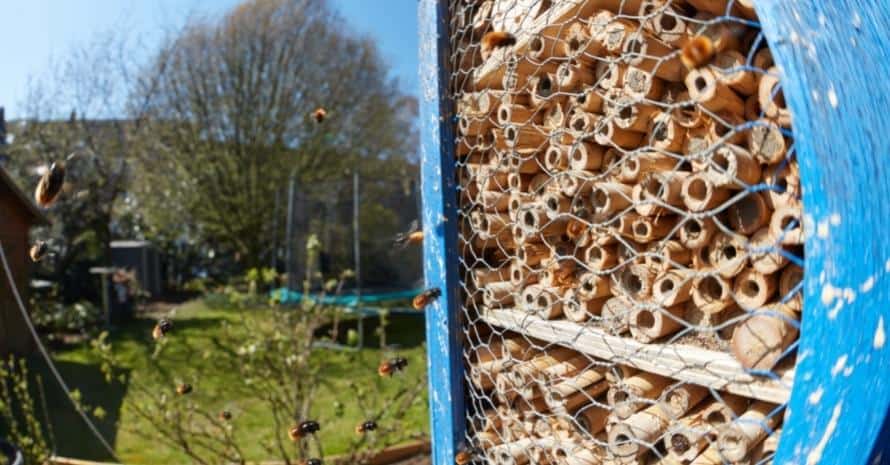
Frankly speaking, it’s pretty hard to distinguish these two bee types for an unprepared person. The main visual differences lie in coloring and body size.
Wild bees frequently have dull colors, moreover, sometimes they can be fully gray. Domestic bees are usually bigger. Wild bees are more aggressive and active, so be careful.
Wasps
- More contrast coloring. Stripes on a honeybee body are darker and have blurred edges.
- Body is visually smaller and tinier.
- Bees’ bodies are hairy and wasps’ ones are not.
- Bee paws are thicker.
Hornets
- Hornets are much bigger than wasps, honeybees or bumblebees.
- Have similarities in body structure with wasps.
- Red tones are presented in coloring
Remember that clearing up a wasp or, especially, hornet nest is very dangerous, so we’d recommend calling for professionals in this case.
How to Get Rid of Bees in Your Walls
After discovering a bee nest in the house, you have a couple of options to choose from:
- Moving the nest to the other place;
- Destroying the nest;
- Leaving the nest in the same place;
Also, if the bees are domestic, you may try to sell the nest to apiarists. The buyer will take care of the hive, and you’ll get a profit.
Bear in mind that these kinds of works are always best left to professionals.
Each of these methods has its own variations and requires special conditions to be applied. In the next paragraphs, we will take a closer look at each of these techniques.
Preparation
First of all, wear tight clothes that don’t leave unexposed areas on your body, including the face. If you have an opportunity, ask a beekeeper to give you a special anti-bite costume. Some winter clothes may be suitable, but nothing can replace professional equipment.
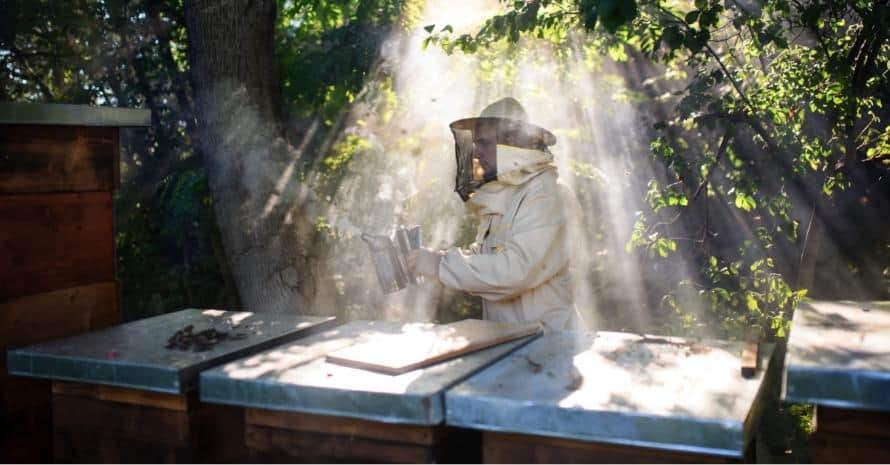
Identify the bees type to choose the time for operation correctly and make sure that you deal with bees but not with hornets or wasps. Wild bees are better to get rid of at the start of the spring.
There are fewer insects in the nest that season, so the chance you’ll be bitten is lower. In contrast, because of continuous cold, domestic bees are weak at the end of the winter. The best daytime for action is early morning or late evening.
Make sure that you’re not emitting any smells, which may anger the bees.
Don’t forget that the hive in the wall might be very heavy (up to 90 pounds!) because of the large amount of honey stored inside, so you should take a helper with you.
Getting Rid of Bees in Walls
Firstly, dissemble wall panels in the place where the beehive is to make further manipulations easier. It may be scary – when angry, the bee swarm will attack you instantly. Once you gain access to the nest, you have a couple of ways to follow.
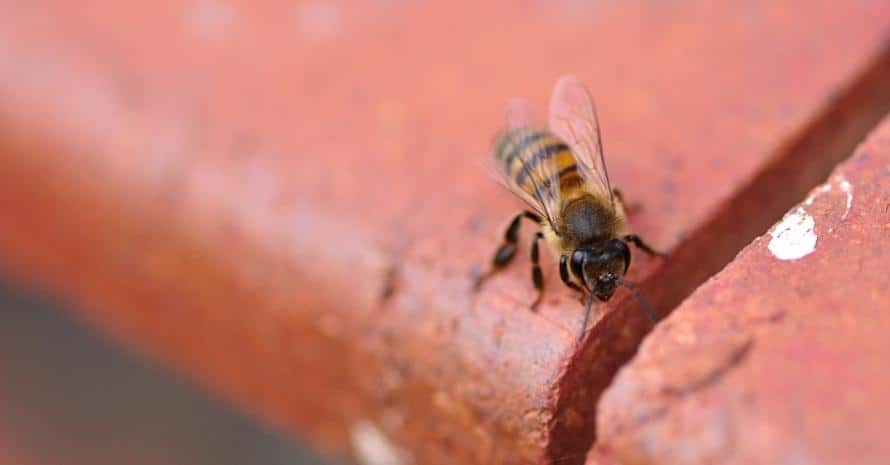
1. Moving the nest to the other place
Bees play a huge role in the local ecosystem. They pollinate blooms and, basically, around 85% of plants with flowers, including fruit trees and vegetables.
The whole food chain would be destroyed without bees, so it’s highly not recommended to kill them or destroy beehives. So, the very first option is to move the nest with the whole swarm to a safer place.
The most widely adopted technique is smoking bees out. Professionals usually use a special device called a smoker, but regular people may use a small bonfire or burning sticks.
A smoke calms down bees in the nest. Also, you can use speakers. Turn on bird sounds at full volume and wait until the bees leave the nest on their own. After smoking out the hive is disconnected from the wall and transported as far as possible from the house.
Sometimes an evicted swarm returns to its original place. To prevent this, the nest is moved to the place where another swarm is already settled. Also, it’s highly recommended to seal all the gaps in the walls and in the roof with polyurethane foam.
2. Destroying the nest
How to kill bees in a wall? On some occasions, when bees from the nest are flying in the house or biting children, desperate measures must be taken.
The most popular and affordable method is to use gasoline or “White-spirit.” The solution is sprayed right into the nest. However, these kinds of chemicals may be dangerous for humans because of their high toxicity and flammability.
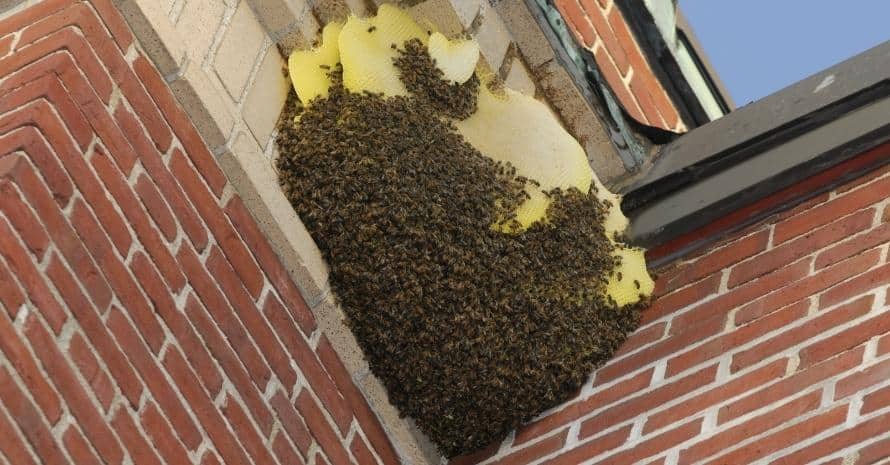
You may use a similar method to the “smoking out” technique. Bees are poisoned with the vapors of burning sulfur fuse.
Using toxic chemicals is the most unpleasant but possible method. Chemicals like “Smell Net” or dichlorvos are sprayed into the nest 2 times at intervals of 1 day. Don’t forget about safety measures while working with chemicals.
After all the bees are killed, the nest is burned off. Don’t forget that destroying the bee nest without good reason is a bad idea.
Some experts answering the “How to get rid of bees nest in wall cavity” suggest sealing all cracks and gaps in the wall making the hive inaccessible for bees.
However, in 90% of situations that is a bad idea: bees most likely will find another way to the nest. Moreover, this new way might be thrown at your house interior, so such a method may be dangerous for you and your family.
3. Leaving the nest in the same place
Sometimes, when the beehive is not a threat for house inhabitants, the nest can be left untouched. However, it’s a rare occasion when the nest sits in the wall.
Bees attack people only when defending themselves or the hive. Even more, bees die after biting. So, sometimes there is nothing critical about living close to the beehive.
How to Prevent Bees
It’s always better to prevent a nest formation as early as possible, so we present a suggestions list for preventing bees in your house.
- Plant herbs like lemon balm, mint or basil. Bees don’t like its smell.
- Seal all the gaps in the walls and in the roof with polyurethane foam.
- Set up some bee traps around your house.
- Set up a drinker for bees in the distance from the house.
- Use an ultrasonic repeller.
Can I Get Rid of the Bee Nest by Myself?
Yes, you can. A correctly defined bee type, right method, good preparation, thoughtful action, and good return prevention will spare you from bees. However, if you are not sure of your abilities, it’s always best to leave the work for professionals.
Have you ever faced a problem with a bee nest in your house? How did you deal with it? Share your experience in the comments below.
Also read:
- How to Get Rid of Carpenter Bees
- How to Get Rid of Ground Bees
- How to Get Rid of Sweat Bees
- How to Get Rid of Carpenter Bees Wd40
- Bumble Bee vs Carpenter Bee
- Citrus Spray for Carpenter Bees
- Carpenter Bee Trap Bait
- How Do Carpenter Bee Traps Work
References
- Why bees are so important to the environment (Department for Environment and Water Comment Policy)
https://www.environment.sa.gov.au/goodliving/posts/2016/10/bees - How to Make a Bee Trap From a 2 Liter Bottle (Danielle Smyth)
https://homeguides.sfgate.com/how-to-make-a-bee-trap-from-a-2-liter-bottle-12442070.html - Dichlorvos
https://www.epa.gov/sites/default/files/2016-09/documents/dichlorvos.pdf

